By Michael N. Ciampo
Ladders have been a mainstay of the fire service for decades, allowing us to rescue civilians and providing access to and egress from burning structures. They have also helped us climb up to rooftops to perform ventilation, cross over burned-out stairs to reach upper floors, and slide out into an ice-covered pond to rescue a person who fell through the ice. Usually we place ladders and then leave them in place until operations conclude. We are taught that if a firefighter goes into a window off a ladder, we should not move the ladder unless we’ve communicated to that firefighter we need it for another life-saving evolution and we’ll move it right back afterward. We also stress that a ladder should cover all sides of the fire building, but if that’s not possible we should at least cover the front and back sides of the building. We all know that because of short staffing or poor tactics at some scenes, this is often not done.
However, if the assigned rapid intervention team (RIT) is making a 360° walk-around the structure and notices no ladders in the rear or other places that need ladders, why can’t RIT members throw them? I understand that RITs are for our insurance and should remain staged as a team in case of a Mayday, but how hard is it to assign two firefighters to throw a portable ladder to an area that needs one? Perhaps that ladder may negate the Mayday transmission because the firefighter can simply self-exit out the window onto the ladder and proceed to the ground to safety.
We should start being more proactive than reactive on the fireground; if you don’t want to use your RIT members to throw ladders, call for more help. In the meantime, while waiting for help to arrive, if there’s an extra engine company, chauffeurs, or available firefighters, order them to throw some ladders.
Scenario
Say you encounter a civilian down in a room with a window on the first floor. It may be difficult to remove that person, especially if the windowsill is high or the victim is large. Or say your initial entry route through the structure to access the victim is in jeopardy and you can’t remove the victim the same way you got to him. What are some methods of removal other than just manhandling him up and out of the window? If you use the same scenario but the victim is a down firefighter, your methods of removal may be a little easier, especially since you can grab onto his self-contained breathing apparatus (SCBA) straps and lift him up.
Improved training in RIT and firefighter removals has resulted in numerous new techniques and tactics. One such tactic is the window cut down. This involves using a chain saw or rotary saw to cut through the sill and down through the structure’s interior and exterior wall to the floor level (photo 1). You cut on both sides of the window and then pull the wall section out of the building, creating an “open door” to slide the victim out to safety (photo 2). It sounds pretty simple and quick, but it has a few flaws. First, what if the structure has those big old cast iron steam radiators or hot water baseboard heating fins in front of the window or has electrical wires or BX cable running through the walls? Will the saw blade/chain come in contact with them? Second, did you remove the depth guard off the saw’s bar to give yourself a full cut? Another problem we saw in training was cutting a home that had aluminum siding. Even though the bullet chain cut through the siding, it cut it like a can opener and the siding bound up around the saw’s sprocket, putting the saw out of service (photo 3). So if you’re attempting this maneuver, always have another saw on standby. In addition, if you encounter aluminum or even vinyl siding, remove it prior to cutting; it will lessen the chances of its binding up in the saw blade, sprocket, or guard or becoming a flying projectile. If you use a rotary saw, the housing of the belt guard will keep the saw a few inches off the one side of the window, making it a narrower opening. It also might not cut both the inside and outside walls together, depending on which size blade you use (photos 4, 5). Some other obstacles on structures that can make this option impractical or delay it include aluminum or metal window frames and concrete block or brick walls. Although many departments might have hydraulic cutting equipment with diamond blades that can cut these materials, such equipment is usually on specialized apparatus and not on location at the typical structure fire.
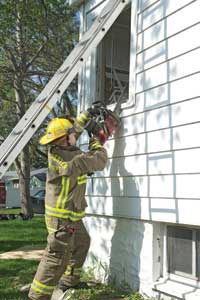 |
|
(1) The chain saw is used to cut a higher window to assist in a removal operation. (Photos 1-6 by J.J. Cassetta.) Click to view video |
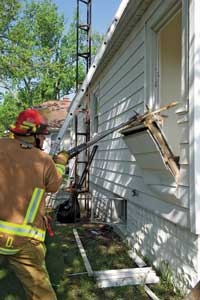 |
|
(2) Two firefighters use hooks to remove the cut section of wall. Click to view video |
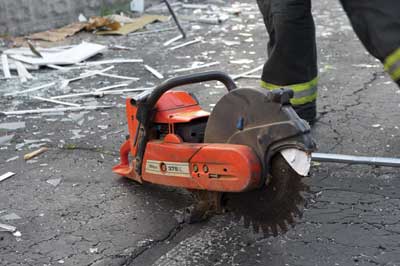 |
|
(3) During training, the siding got caught in the blade shroud and bound up the blade. Click to view video |
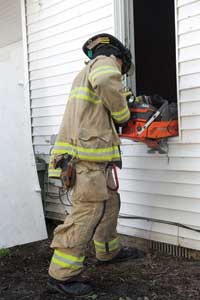 |
| (4) A rotary saw might not be able to cut both sides of the wall in one cut, and the saw housing may keep it off either side of the window, making a narrower opening. |
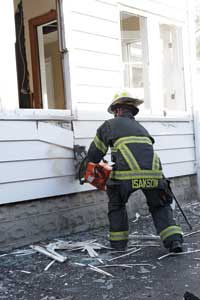 |
| (5) A rotary saw might not be able to cut both sides of the wall in one cut, and the saw housing may keep it off either side of the window, making a narrower opening. |
The window cut-down tactic has been successful in routine removals of obese victims from their homes under nonfire conditions, but if you add smoke and no visibility to the equation, you must use good communications to prevent accidents. I had the opportunity to try the window cut-down vs. the victim removal with a portable ladder in side-by-side dwellings scheduled for demolition. Astonishingly, the ladder removals were faster compared with cutting the structure to remove the victim. Plus, the method required only one tool that should be in close vicinity on any fireground—the portable ladder.
See-Saw Technique
The see-saw ladder removal technique is simple to perform at various window heights on the first floor. Basically, slide a ladder into a window, place the victim onto it, and then slide the ladder out. Of course, it requires a little communication and coordination between the members inside and the members outside. You can use a straight, a roof, or an extension ladder. If your department has a lot of porch roofs that you ladder for upper-floor egress for vent-enter-search with roof ladders, use those ladders. If there is an extension ladder thrown to a window nearby and you must use it, remember to communicate to those members operating inside that you are taking their means of egress. Inform the incident commander that you need the ladder to perform the rescue and that another ladder can be positioned in its place.
If you’re using a roof or an extension ladder, it really doesn’t matter which end (tip or butt) you slide into the room. If you use the roof ladder and the hooks go into the building, be careful when you slide the ladder out that the hooks don’t open up and catch on the sill. Often the hooks support the victim’s or firefighter’s feet but can deflect downward from the victim’s weight (photo 6). If you use the extension ladder, lock it and tie it off in the nested position; this helps keep the sections locked together and limits any shifting of the ladder during the removal. The fly should be facing upward with its base section resting on the sill so when firefighters grab the bed section to pull it out of the window, the ladder’s fly will not move. If you put it into the window butt first with the fly down, be careful when you pull it out that it’s properly tied off, and remove it slowly and cautiously so the fly doesn’t move. If the fly moves, it could pinch a firefighter’s hands between the rung and rail.
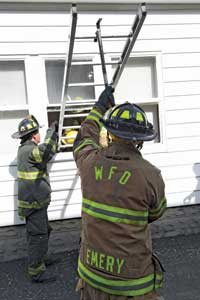 |
| (6) Place the roof ladder into the window with the tip first to perform the maneuver. If it’s difficult to reach the rung, use a hook to pull it down. Remember that the farthest rung back offers the most leverage or mechanical advantage. |
While drilling on this maneuver, we left the window intact for a few evolutions, just to see how a firefighter’s profile with bunker gear and SCBA on would fit through the opening; it worked well. The problem arose in a few of the older window installations when the windows slid downward during the removal from the vibration of the ladder on the sill. Just follow one of our mantras: Complete removal of the window, sash, curtains, and blinds will assist in the removal of a victim using this technique.
Room size, room layout, and the victim’s position often dictate how far to extend the ladder into the room. If necessary, stand the bed mattress and frame up against the wall, or stack the furniture to one side of the room to afford enough space to put the victim onto the ladder. When sliding the ladder into the room, don’t put it inside the window past its midpoint—doing so hinders the see-saw motion you make during the removal. Place the ladder just far enough inside the window to get the victim completely onto it. The more ladder outside the window increases the mechanical advantage or lever action and makes the removal that much easier. The window height also dictates the ladder angle: The higher the windowsill, the higher an angle the ladder projects outside the window. With a little practice, you can use this maneuver even on a high window.
Displaying 1/2 Page 1, 2, Next>
View Article as Single page
Fire Engineering Archives


